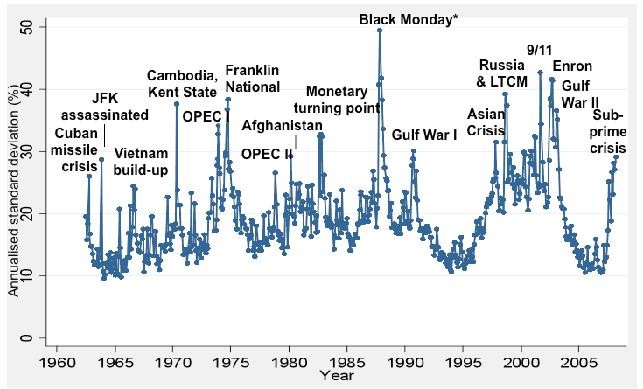Volatility and the Stock Market
Post on: 1 Июль, 2015 No Comment

VIX vs. S&P Over the Past Three Years
Market Volatility on the Edge
Is market volatility running high? … or is it running low (maybe too low)?
I’ve read several news articles just this week saying the market is increasingly volatile. I’ve also seen analyses expressing surprise that volatility hasn’t jumped higher as the S&P has slid 7.2% from its September high.
The answer is that volatility-as measured by the CBOE Volatility Index (VIX)-is right now on the borderline between historical high and low.
The VIX is based on S&P options, where option pricing reflects traders’ volatility expectations. When options are expensive (relative to stock price, etc.), it means traders are betting on high volatility; when options are cheap, it means traders are betting on low stock volatility. The VIX index quantifies what volatility traders must be expecting.
Analysts generally use the VIX as a measure of investor sentiment. High VIX reflects high uncertainty. And because markets are usually more volatile when prices are falling, a high VIX can also suggest high expectations for falling prices.
A low VIX means low expected volatility, which is more associated with expectations of rising prices.
What’s high and what’s low depends on the time span you consider. The 20-year chart below shows four alternating VIX eras; low from 1993 to 1996, then high from 1997 to 2003, then low again from 2003 to 2007, and back to high from 2007 on. The dividing line between high and low is in the area of .14 to .18. The VIX is currently at .16, right in that boundary zone.
%img src=http://www.cabot.net/
/media/Images/CWA%20Images/2012/Chart%201%201120.ashx /%
Relative to the high VIX era that started in 2007 (ranging all the way from .14 to .80), current volatility is very low. Even setting aside that astonishing VIX spike up to .80 in late 2008 (the height of the financial crisis), current readings are at about one-third the levels posted in short bursts in 2010 and 2011.
The second chart takes a closer look at the last three years. It shows four occasions when VIX dipped down to (and a little below) the current level.
The first low was in April 2010, followed by a sharp spike as the market corrected for three months. The second low was in April-May 2011, again followed by a VIX spike as the market corrected for five months. The third occasion was in March 2012, followed by a less dramatic VIX rise as the market corrected for two months. The final VIX low of these three years was in September 2012, and the market has pulled back for the two months since.
%img src=http://www.cabot.net/
/media/Images/CWA%20Images/2012/chart%202%201120.ashx /%
The VIX has been rising as the market retreated over these last two months. But it hasn’t risen very much, and it’s still in that borderline zone between high-eras and low-eras. For now (until proven otherwise), the presumption has to be that volatility is still low in a continuing high-VIX era, rather than (potentially) high in a new low-VIX era.
What does it all mean? Simply that additional market weakness is unlikely unless/until either (a) VIX spikes higher again, or (b) the market enters a new low-VIX era by sliding down below the boundary zone to about .14 to .16.
Your guide to ETF investing,
Robin Carpenter
Editor, Cabot ETF Investing System
Related Articles:














